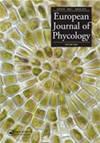Philozoon Geddes在北半球和南半球沿海温带动物身上为寄主特化甲藻“虫黄藻”复活
IF 1.7
4区 生物学
Q2 MARINE & FRESHWATER BIOLOGY
引用次数: 27
摘要
共生鞭毛科(dioflagellate family Symbiodiniaceae)由众多属、种组成,在多样性、生态和地理分布上存在较大差异。在温带共生刺胞动物中常见的进化上不同的谱系,在文献中被指定为几个非正式名称,包括“温带A”,AI, A ' (A-prime)和“地中海A”,这里被分配给Philozoon属。这个属是由Geddes(1882)在最早的一篇论文中提出的,该论文认为“黄细胞”是与动物和原生宿主分离的独特生物实体。利用核(rDNA)、叶绿体(cp23S)和线粒体基因(cob和cox1)的系统发育数据,以及形态(细胞大小)、生态性状(寄主亲和力)和地理分布,对Philozoon Geddes属及其两个种P. medusarum和P. actiniarum进行了修订,并描述了6个新种。每种共生体物种对特定种类的海葵、软珊瑚、石珊瑚和根茎水母都有很高的寄主保真度。Philozoon与symbiodiium(以前的进化门A)关系最密切,但与热带的同类物种不同,它的宿主生活在北半球和南半球的浅温带海洋栖息地,包括地中海、大西洋东北部、澳大利亚东部、新西兰和智利。在高纬度、温度波动较大的生境中,存在一种适应刺胞动物宿主的物种多样性谱系,这进一步引起了人们对共生体科生态和生物地理范围的关注。与温带无脊椎动物共生的鞭毛属被表征并使用从自然历史学家的黄金时代复兴的废弃分类术语命名。这项工作强调了动物-藻类的共生关系是如何在广泛的环境条件下进化而茁壮成长的。本文章由计算机程序翻译,如有差异,请以英文原文为准。
Revival of Philozoon Geddes for host-specialized dinoflagellates, ‘zooxanthellae’, in animals from coastal temperate zones of northern and southern hemispheres
ABSTRACT The dinoflagellate family Symbiodiniaceae comprises numerous genera and species with large differences in diversity, ecology and geographic distribution. An evolutionarily divergent lineage common in temperate symbiotic cnidarians and designated in the literature by several informal names including ‘temperate–A’, AI, Phylotype A´ (A-prime) and ‘Mediterranean A’, is here assigned to the genus Philozoon. This genus was proposed by Geddes (1882) in one of the earliest papers that recognized ‘yellow cells’ as distinct biological entities separate from their animal and protist hosts. Using phylogenetic data from nuclear (rDNA), chloroplast (cp23S) and mitochondrial genes (cob and cox1), as well as morphology (cell size), ecological traits (host affinity) and geographic distributions, we emend the genus Philozoon Geddes and two of its species, P. medusarum and P. actiniarum, and describe six new species. Each symbiont species exhibits high host fidelity for particular species of sea anemone, soft coral, stony coral and a rhizostome jellyfish. Philozoon is most closely related to Symbiodinium (formerly Clade A), but, unlike its tropical counterpart, occurs in hosts in shallow temperate marine habitats in northern and southern hemispheres including the Mediterranean Sea, north-eastern Atlantic Ocean, eastern Australia, New Zealand and Chile. The existence of a species-diverse lineage adapted to cnidarian hosts living in high latitude habitats with inherently wide fluctuations in temperature calls further attention to the ecological and biogeographic reach of the Symbiodiniaceae. HIGHLIGHTS A dinoflagellate genus symbiotic with temperate invertebrates is characterized and named using a discarded taxonomic term revived from the golden age of Natural Historians. The work highlights how animal–algal mutualisms are evolved to thrive under a broad range of environmental conditions.
求助全文
通过发布文献求助,成功后即可免费获取论文全文。
去求助
来源期刊

European Journal of Phycology
生物-海洋与淡水生物学
CiteScore
4.80
自引率
4.20%
发文量
37
审稿时长
>12 weeks
期刊介绍:
The European Journal of Phycology is an important focus for the activities of algal researchers all over the world. The Editors-in-Chief are assisted by an international team of Associate Editors who are experts in the following fields: macroalgal ecology, microalgal ecology, physiology and biochemistry, cell biology, molecular biology, macroalgal and microalgal systematics, applied phycology and biotechnology. The European Journal of Phycology publishes papers on all aspects of algae, including cyanobacteria. Articles may be in the form of primary research papers and reviews of topical subjects.
The journal publishes high quality research and is well cited, with a consistently good Impact Factor.
 求助内容:
求助内容: 应助结果提醒方式:
应助结果提醒方式:


